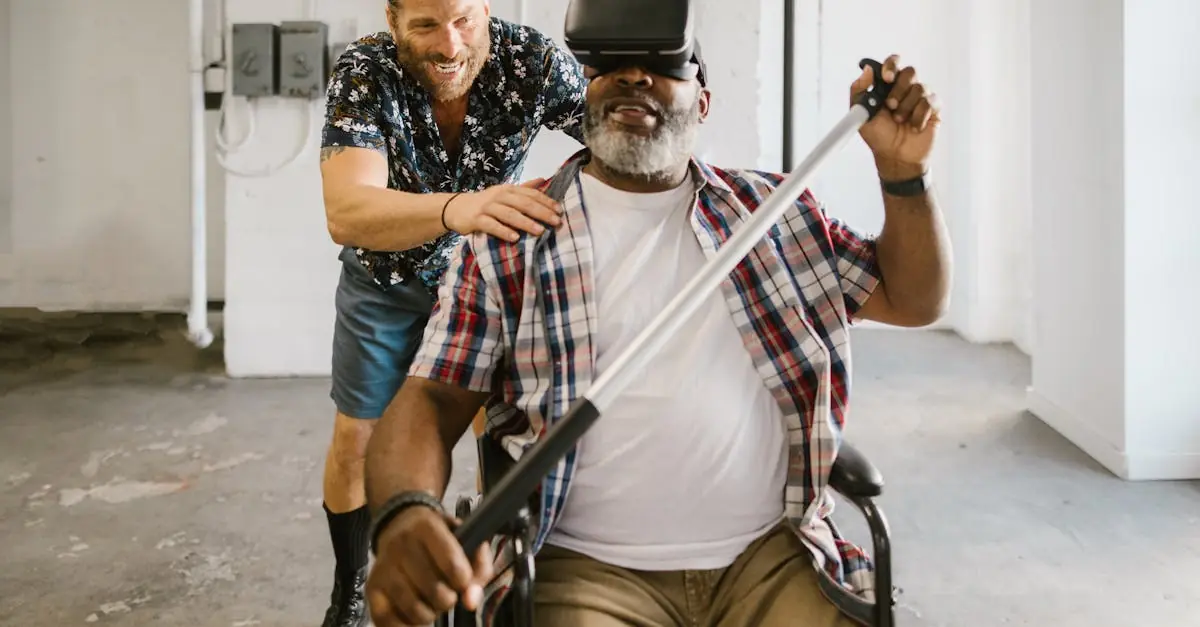Imagine slipping into a world where you can battle dragons, explore distant galaxies, or chill on a tropical beach—all without leaving your couch. Welcome to the realm of mobile VR, where the magic of virtual reality fits snugly in your pocket. With just a headset and your smartphone, the ordinary transforms into the extraordinary, making every moment an adventure waiting to happen.
Mobile VR isn’t just for tech geeks anymore; it’s for anyone who craves a little escape from reality. Whether it’s a quick five-minute escape during a coffee break or an immersive experience that lasts for hours, mobile VR delivers thrills at your fingertips. So why not dive in? The virtual world is calling, and trust us, it’s way more exciting than scrolling through social media for the hundredth time.
Table of Contents
ToggleOverview of Mobile VR
Mobile virtual reality (VR) enables immersive experiences through smartphones and portable headsets. Users access stunning environments, including fantastical worlds or thrilling adventures, directly from their mobile devices. High-quality graphics and responsive interactions bring these experiences to life, captivating a wide audience beyond just tech fans.
Different mobile VR platforms exist, including Google Cardboard, Samsung Gear VR, and Oculus Quest. These systems create an engaging escape, whether for a few minutes or several hours. Many applications and games leverage mobile VR to enhance user experience, offering gameplay that encourages interactivity and participation.
The convenience of mobile VR sets it apart. Users can enjoy it anywhere, whether at home or on the go. As mobile devices continue to advance in processing power and display quality, the potential for more realistic and engaging VR experiences grows. Content availability also expands, as developers create innovative applications aimed at various interests and demographics.
Popularity among casual users has surged, driven by a desire for accessible entertainment options. Rather than remaining confined to traditional gaming avenues, mobile VR invites participation from diverse age groups and backgrounds. Enhanced social features further enrich these platforms, allowing friends to share experiences seamlessly, regardless of distance.
Mobile VR continues to evolve, with ongoing developments in technology and software. Future advancements promise to enhance the realism and interactivity, keeping users captivated and engaged. Enhanced user experiences draw in casual participants and dedicated gamers alike, elevating mobile VR as a must-try technology for all.
Advantages of Mobile VR
Mobile VR offers numerous advantages, enhancing the overall user experience through various dimensions.
Portability and Convenience
Portability ranks high among mobile VR’s perks. Users can take their VR set-ups anywhere, making it suitable for on-the-go entertainment. Compact size allows users to enjoy immersive experiences during commutes, vacations, or at home. Convenience enhances the enjoyment of VR, with quick setups requiring minimal space. Engaging in activities like gaming or virtual travel becomes effortless, fitting seamlessly into busy lifestyles.
Accessibility and Affordability
Accessibility stands out as a core benefit of mobile VR technology. Unlike traditional VR systems, mobile options provide a low entry point. Many platforms, such as Google Cardboard and Samsung Gear VR, require only a smartphone, making VR reachable for a wide audience. Affordability contributes to increased user engagement across various demographics. Cost-effective headsets attract casual users, expanding the community and inviting more people to experience virtual adventures.
Popular Mobile VR Devices
Mobile VR devices offer a diverse range of options, making virtual reality experiences accessible and enjoyable for many users. From smartphones to standalone headsets, there are various choices available.
Smartphones Compatible with Mobile VR
Many smartphones support mobile VR, providing users with a convenient way to dive into virtual experiences. Samsung Galaxy series is particularly noteworthy, especially models like the Galaxy S10 and S20, which boast powerful processors and high-resolution displays. Google Pixel devices, such as the Pixel 4 and 5, also excel in delivering rich VR content. OnePlus phones, including the OnePlus 8 and 9, support mobile VR, enabling enhanced immersion. A diverse library of VR apps ensures users can explore captivating environments and interactive games seamlessly.
Standalone Mobile VR Headsets
Standalone mobile VR headsets represent a significant advancement in the industry, eliminating the need for external devices. Oculus Quest 2 stands out with impressive features like high-resolution displays, advanced tracking, and a diverse content library. HTC Vive Flow offers portability and functionality, making it suitable for on-the-go experiences. Pico Neo 3 provides an alternative for users seeking a wireless headset, complete with solid performance and immersive graphics. Each of these headsets enhances the mobile VR experience, offering users the freedom to explore new realities without limitations.
Immersive Experiences in Mobile VR
Mobile VR offers unique, immersive experiences that transport users into captivating worlds. It enables exploration in ways that traditional media cannot, providing a thrilling escape from everyday life.
Gaming Applications
Mobile VR excels in gaming, delivering intense experiences that engage players. Users can battle fierce dragons in fantastical realms or race high-speed vehicles in realistic simulations. Popular titles, such as “Beat Saber” and “Rush of Blood,” showcase the diversity available on platforms like Oculus Quest and Samsung Gear VR. Players enjoy intuitive controls that enhance the immersive nature of these games, with multiplayer options allowing for competitive play with friends. The convenience of mobile VR enables gamers to dive into adventures whether at home or on the go.
Educational and Training Uses
Mobile VR transforms educational methodologies, offering innovative ways for users to learn and develop skills. Students explore historical sites and scientific phenomena through interactive simulations that deepen their understanding. For instance, medical students can practice surgical techniques in a risk-free environment, enhancing their training experience. Various industries utilize mobile VR for employee training, improving retention and engagement by simulating real-world scenarios. With access to powerful educational apps, users can engage with content that makes learning dynamic and accessible on their smartphones.
Challenges and Limitations
Mobile VR faces several challenges and limitations that impact user experiences. Understanding these factors is crucial for anyone looking to explore this technology.
Hardware Constraints
Mobile VR is often hindered by hardware limitations. Many smartphones lack the processing power found in dedicated gaming PCs. This results in lower graphical fidelity and a less immersive experience. Battery life also poses a significant issue, as VR applications consume substantial power. Users may experience overheating or quick battery drainage during extended use. Additionally, the weight and comfort of headsets can affect prolonged wear. These factors can deter users seeking consistent and enjoyable experiences.
Content Availability
Content availability is another challenge for mobile VR. While many apps exist, the depth and quality can vary greatly. Not all VR experiences translate well to mobile platforms, leading to a limited selection of engaging titles. Some users may find that popular franchises or genres are underrepresented in mobile VR. Developers often prioritize high-end systems, leaving mobile experiences sidelined. As a result, users may feel restricted in their content choices, impacting their overall enjoyment.
Future Trends in Mobile VR
Mobile VR continues to evolve as technology advances, offering exciting possibilities for users. Improved hardware enhances graphical fidelity while extending battery life, addressing previous limitations.
Technological Advancements
Advancements in smartphone processors lead to better performance in mobile VR applications. The introduction of 5G technology allows for smoother streaming and quicker content access, minimizing latency. New display technologies, such as OLED and AMOLED, provide sharper visuals and vibrant colors, enhancing immersion. Innovations in motion tracking improve user interaction, creating seamless experiences in virtual environments. As developers utilize artificial intelligence, personalized experiences become more relevant, adapting to individual user preferences and behaviors.
Expanding Market Potential
Market growth for mobile VR shows significant potential as more devices become available. Diverse industries, such as healthcare and education, embrace mobile VR for training and simulation purposes. Increased affordability allows broader audience access, attracting casual users whose interest in VR has surged. Developers focus on creating engaging content that appeals to various demographics, expanding the user base. Partnerships between technology companies and content creators stimulate further innovation and collaboration, driving the mobile VR market forward.
Mobile VR is redefining how users engage with entertainment and education. Its accessibility and affordability invite a diverse audience to explore immersive experiences that were once reserved for specialized devices. With advancements in technology, the future looks bright for mobile VR, promising even richer and more realistic environments.
As more people discover the joys of mobile VR, its potential to enhance social interactions and create shared experiences becomes increasingly evident. The combination of portability and convenience ensures that users can dive into captivating worlds anytime and anywhere. Embracing mobile VR isn’t just about entertainment; it’s about stepping into a new realm of possibilities.



